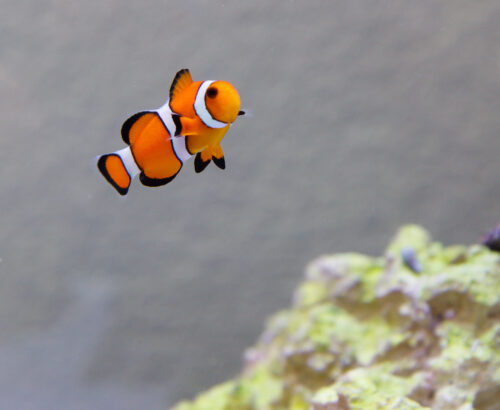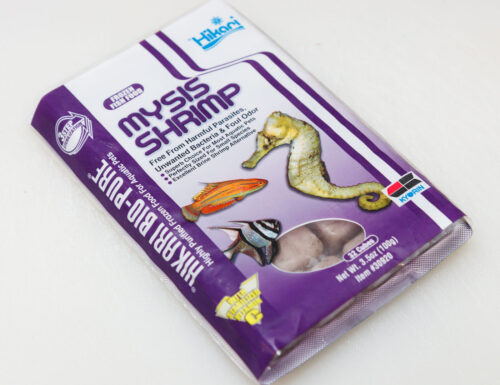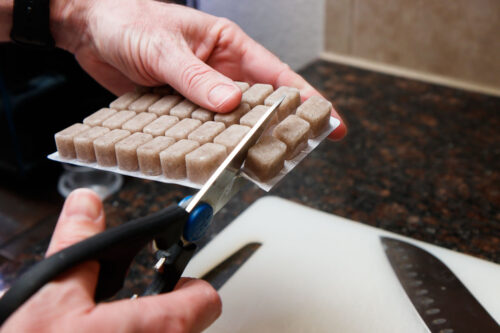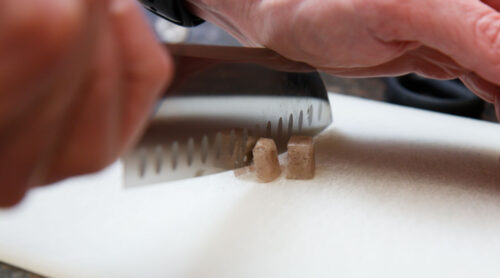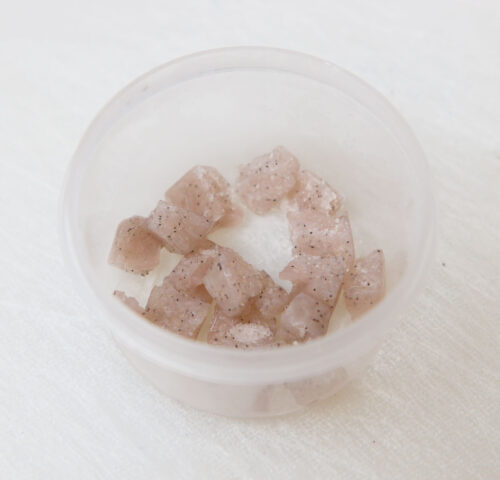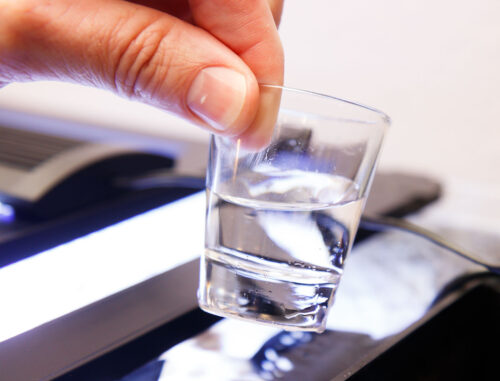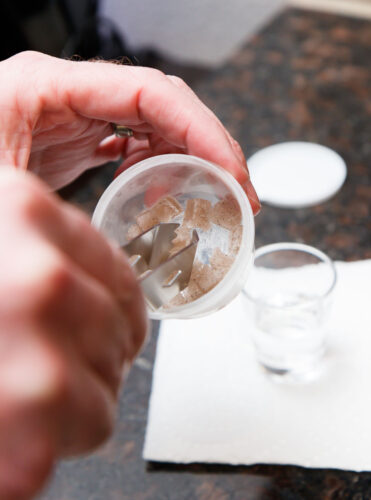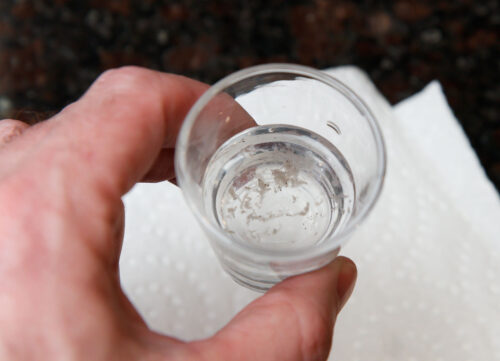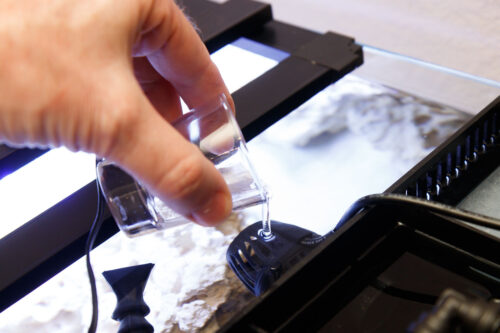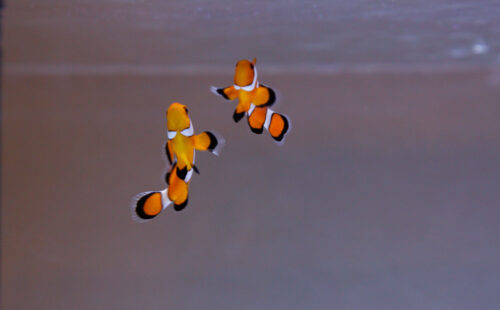I’ve kept freshwater fish for many years so feeding fish is no new thing for me; however, feeding in our saltwater nano gave me an opportunity to try feeding frozen foods for the first time.
I’ll discuss a bit of what the general goals are for feeding in a saltwater tank as well as some detailed instructions on how we prepare frozen food for our fish, dry food we use, and guidelines for how much and how often to feed fish in a nano saltwater tank. The approach will be specific to nano reef tanks that are new (with little or no coral feeding).
Fish Feeding Goals:
We can all inherently appreciate the need for food, so it’s easy to understand that nutrition is important for fish and other animals in your saltwater aquarium to survive and thrive. It’s also easy to correlate with our diet and see that for our fish and inverts to be healthy, variety in the foods we provide is also important.
So, the first feeding goal for our nano reef is to provide different kinds of food for variety. For our freshwater tank, I have typically fed only one type of dry food. For our nano reef, I will start out with two types of food – dry pellet food and frozen food. By providing a variety of foods, we hope to ensure all the nutritional bases are covered.
The second feeding goal is to provide a quantity and frequency of feeding that meets the nutrient needs of the animals and the system. This is not an exact or known amount, but starting out it is probably beneficial to err on the side of less instead of more. I’ll discuss more later on how to make adjustments to feeding frequency and quantity.
Food Options for a Beginner Saltwater Nano:
The exact types of foods you decide on should be tailored to the fish/inverts of your tank. I will discuss what I’m feeding in our tank that currently contains (2) clownfish and some snails.
Pellet Food Option:
I know that I’m not always going to have the time or desire to thaw out frozen food for a feeding (even though it’s super easy) so a good pellet food option is a must. Also, when we leave for vacation, pellet foods can be used in an auto feeder or will be easier for a tank sitter to administer.
I found a product from Sustainable Aquatics called Dry Hatchery Diet. It’s specifically made for clownfish (although I bet it would be a successful food for many other fish and critters, perhaps even as food for some corals).
Right now, I don’t feel a need for multiple pellet food options.
Frozen Food Option:
There are a myriad of frozen fish foods out there. Two popular brands that I have come across are Hikari and Rod’s Food.
I wanted to start with a simple food good for juvenile fish. Mysis shrimp meet this need. I decided to start with Hikari’s Mysis Shrimp.
Quite honestly, a big selling point for Hikari’s frozen foods are the ‘blister pack’ that they are packaged in. This allows you to only open a single cube (1 / 32 of a pack) and leave the remaining portions sealed. This makes managing the smaller portions of a nano tank easier.
How to Feed Frozen Food in Your Saltwater Nano:
Feeding frozen food ended up being super easy, but to make it quick and simple for feed time, you need to do a little prep.
Preparing Frozen Foods for a Nano Reef Tank:
Nano tanks require very small portions of frozen food, especially a new tank that is sparsely populated and might be prone to algae (triggered by excessive nutrients).
Step 1 – Portion the Food: I take each cube of the Hikari frozen food and divide it. Starting out, I cut each cube into (8) pieces. I have since started feeding slightly more and only divide each cube into (4) pieces. If you are dealing with larger slabs of frozen food, I’d suggest cutting a section into portions and storing the remaining food as airtight as possible.
The easiest tools and methods I’ve found to divide frozen fish food is to use a large chef knife and cutting board. Use the butt end of the knife to cleave straight down.
Work fast because the food defrosts quickly. I only get a few cubes out of the freezer at a time to work with.
Step 2 – Store the Food: Take your frozen food bits and move them into a small, sealable Tupperware container.
How to Feed Frozen Fish Food:
I think some people just toss the food bits in frozen, but this is not ideal. Best practice is to first thaw the food.
I have a few simple tools that help make thawing and dispensing fish food super easy:
- Shot Glass
- Stainless Serving Tongs (optional, but nice)
- Towel
Thawing fish food for a feeding is very easy. Remove your tank lid or scoot it partially off. Dip the shot glass into your tank to fill it about 1/2 to 3/4 full. Set the glass on your towel.
Get your Tupperware container of portioned fish food out of the freezer. I then use my stainless tongs to grab a piece and drop it into the shot glass water. The tongs are certainly optional, but it’s an easy way to keep your hands from smelling like carp.
Small portions don’t take long to thaw in the warm tank water. Fifteen minutes is plenty and it’s often times ready before then.
Check that it is thawed by swirling the shot glass a bit. If the food breaks up easily, it’s ready to add to the tank.
I have a number of ways that I feed but generally, I do the following:
- Turn off the return pump.
- Adjust the wavemaker to low speed.
- Slide the top back to clear the area over the wavemaker.
- Slowly pour the water/food from the shot glass over the area of the wavemaker.
The flow from the wavemaker slowly moves food about the tank and encourages feeding. I’ve tried it with all flow off (both the return pump and the wavemaker) but the food sometimes falls and settles too fast for the fish to consume.
I find it super satisfying to watch fish eat the large bits of fleshy food. Make sure to take some time to observe and enjoy your fish in feeding frenzy mode.
Leave the return pump off for a time to let all the critters have an opportunity to eat (even the nasarius snails). I usually turn it back on after 15 minutes or so.
Tips for Handling and Feeding Frozen Fish Food:
A few pointers and guidelines for dealing with frozen fish food:
- Avoid letting it thaw before you are ready to feed. This includes transporting from the fish store. Have a insulated container with ice if necessary to make sure you get it home still frozen.
- If the food does thaw, do not feed it. It goes bad and will need to be tossed out.
- Don’t thaw and refreeze frozen fish food. Refreezing forms crystals in a manner that damages the food. If you thaw too much to feed, throw the excess away.
- Try to store airtight to avoid ‘freezer burn’.
- For portioned food bits, don’t prepare too much. Even though the Tupperware container is sealed, it still has air entering every time you feed; these bits will get freezer burn eventually.
Thoughts for Feeding Quantity and Frequency in a Nano Saltwater Aquarium:
This is a million dollar question that. . . I don’t have an answer for. Honestly, there is no exact answer and like many aspects of this hobby, quantity and frequency of feeding will need to be learned and adjusted by feel and observation.
The strong tendency for beginners is to feed too much and too often. There is no danger to the fish and critters by overfeeding (at least short term). They can’t eat themselves to death or even hurt themselves from overfeeding. The pitfall to overfeeding is excessive nutrients.
Excessive nutrients can lead to a number of issues. Often, nitrates and phosphates will rise above acceptable targets. The end result is often undesirable algae taking over. New tanks are often more susceptible to overfeeding leading to algae; nano tanks can often suffer from overfeeding effects faster and harder than larger tanks.
At the onset of our tank, I typically fed around 5 times a week. A typical feeding schedule might be:
- Sunday – Don’t feed.
- Monday – small pinch of dry food.
- Tuesday – 1/8 cube of frozen food (mysis shrimp)
- Wednesday – Don’t feed.
- Thursday – small pinch of dry food.
- Friday – 1/8 cube of frozen food (mysis shrimp)
- Saturday – small pinch of dry food.
Easy. I think it’s important to let your fish ‘fast’ without food occasionally as it might help them fully clear out their digestive system. Not to mention it lessens the bioload on your tank.
This lean feeding schedule worked well at the onset with juvenile fish (that didn’t eat much yet) and no corals. As the fish have grown I have increased quantity slightly but still utilize one or two days a week as fasting days.
The addition of corals is a fun change as then you have an entirely new dimension to consider. I’ve started to use coral specific foods and that is definitely worth another article in the future.
Summary for Saltwater Nano Feeding:
Feeding time is a great time of interaction and enjoyment of your saltwater tank. Three points of summary:
- People wouldn’t be healthy (or happy) eating the exact same food all the time. In the same way, administer a variety of foods to your tank.
- Don’t be afraid of frozen fish foods – with a little prep, they are easy to feed to your tank and offer a great variety of nutrition options.
- Try not to overfeed. Be observant and adjust feeding quantity over time to match the changing conditions of your aquarium.
As I alluded to, additional considerations for tank nutrition evolve if you add corals. I will follow up in the future with some specialized feeding options for corals.
Up next in the series is Part 12: Nano Reef Maintenance.


